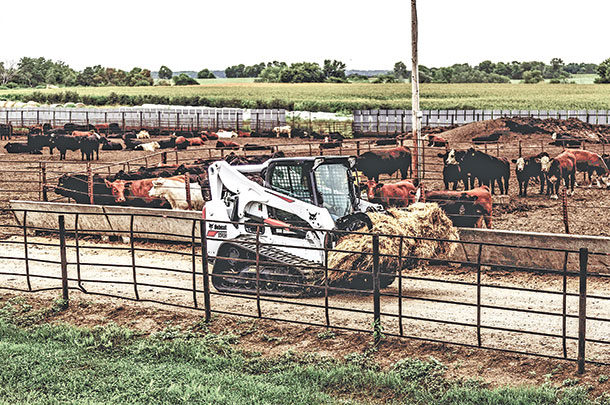However, today nearly all compact loader manufacturers use advanced engine technologies – designed with high-pressure common-rail (HPCR) systems and sophisticated fuel injectors – which have become less tolerant of contamination.
Hostile elements, such as water, debris and other contaminants, can work against fuel quality and cleanliness. By following these recommended fuel best practices, you can help reduce machine downtime and costly injector plugging caused by fuel contaminants.
Select the best supplier
Purchasing clean fuel that is properly blended for the climate is the first step in good fuel management. You may have to pay more for clean fuel, but investing in quality fuel may lower your consumption, reduce the number of necessary filter changes and deliver long component life for better peace of mind.
Make sure your supplier uses water-removing filters rated to 10 microns or less on their fuel delivery lines and confirm they have a winter blend of No. 1 and No. 2 diesel with a low cloud-point temperature. A good fuel distributor will provide diesel fuel that meets specifications for most climate environments.
Confirm the fuel’s cloud point
Today’s ultra-low-sulfur diesel (ULSD) fuel is produced with sulfur levels less than 15 parts per million (ppm), which is a significant reduction from years past when sulfur levels ranged as high as 500 ppm. The change in sulfur content was necessary to lower emissions, but the process used to remove sulfur also increases saturates, which in turn increases the fuel’s cloud point.
Cloud point is defined as the temperature where wax begins to drop out of fuel, creating a translucent appearance. The wax forms crystals, ranging from 50 to 200 microns in size, which can quickly plug your loader’s fuel filter.
Ask your diesel fuel supplier to confirm the fuel’s cloud point since it is dependent on the geographic location and the time of year that fuel is intended to be used. For example, fuel available in North Dakota during September will have a different cloud point than fuel available in Texas in July.
Prepare for cold weather
Chemistry changes to today’s diesel fuel make it harder for fuel suppliers to consistently provide high-performing fuel.
To make sure your fuel performs well, you can utilize cold-weather practices, including removing trapped water from your loader’s fuel filter daily, maintaining a machine’s battery state of charge, and choosing the best engine oil and hydraulic/hydrostatic oil for the temperature conditions.
In addition, fill your compact loader with a higher percentage of winter-blend diesel fuel and begin using it earlier in the season. Operations in cold and far northern regions should use a special winter-blend fuel – typically No. 1 and No. 2 diesel fuel – to prepare the machines for cold temperatures.
It is beneficial to maintain a cold-weather kit, purchase cold-weather accessories and to follow cold-starting procedures as outlined in your loader’s operation and maintenance manual. Read it thoroughly to learn about cold-starting procedures and minimize machine downtime.
Test bulk fuel tanks every six months
To avoid pump, filter and injector problems, either you or a professional diesel fuel-cleaning and inspection service should test your supply tanks for water or other contaminants in your storage tank every six months.
If you decide to test fuel, there are a variety of fuel testing and analysis kits to measure the cleanliness, percentage of water, cloud point and several other categories.
Typically, small amounts of water can be removed, but if significant amounts of water or sludge are found, the entire storage tank should be drained and cleaned.
Keep supply tank fuel filters clean
Fuel sitting in 5- or 10-gallon plastic containers may not be contaminant-free. To help prevent contaminants and increase the effectiveness of the loader’s fuel filter, make sure any fuel entering a storage tank passes through a dispensing filter.
In addition, fuel tank filters should be capped, and the tank should have a 1-micron vent filter. Tank filters typically have a 10-micron-or-finer filter to filter free and emulsified water to help ensure quality fuel to your loader.
Use 2-micron fuel filters
Some fuel filters chosen for HPCR engines can trap down to 2-micron contaminants, helping remove free and emulsified water. Although no filter will remove all contaminants, using the cleanest fuel possible and using an efficient fuel filter can help minimize the number of particles entering the loader.
It is also important to consider the following best practices:
- Drain the water trap daily.
- Never prefill a new filter during installation.
- Never open fuel connections in the system upstream of the fuel filter.
- Use the manufacturer’s recommended replacement fuel filter.
It is also best to have an extra fuel filter for every Tier 4 HPCR-engine-equipped loader on hand and keep it on the jobsite in case contaminated fuel is used in a machine and the filter needs to be replaced on site.
Fill machine tanks at the end of each workday
HPCR engine technology generates higher fuel temperatures, and as the machine cools, condensation can form in air gaps. As a best practice, make sure every loader is filled with diesel fluid at the end of the workday to prevent potential condensation and reduce maintenance costs.
By following these seven fuel best practices, you can cut down on costly injector plugging from water, debris and other contaminants found in diesel fuel for longer compact loader life. ![]()
Chris Girodat is a marketing manager with Bobcat Company.
PHOTO: Today’s newer engines are less tolerant of diesel fuel contaminants and can result in injector plugging and machine downtime. Photo provided by Chris Girodat.










